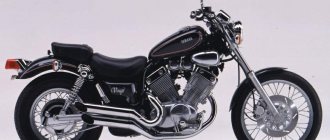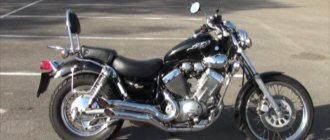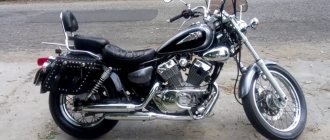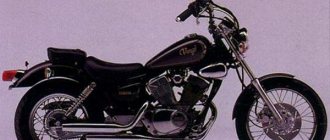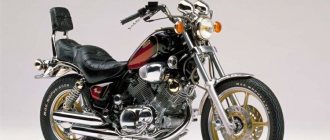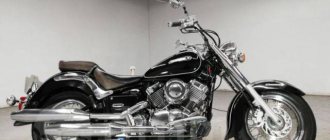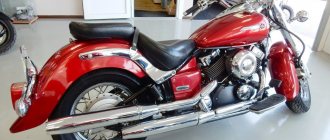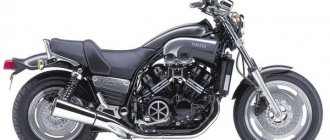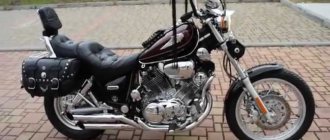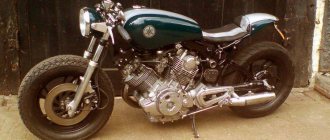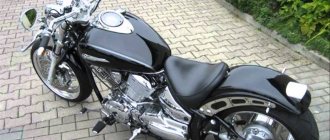Japanese motorcyclesYamaha motorcycles
Japanese companies, interested in the vast American market for motorcycle products, rushed to conquer it.
And since the American buyer is spoiled by their own products, Japanese companies had to adapt to these realities.
The pioneer in the creation of American-style cruiser road motorcycles was Yamaha. It was she who released the first cruisers with a V-twin engine.
The first models were designated XV-1000TR1, with a liter engine 750 cc model XV-750 Special, and they were released in 1980. A little later, these models were given the name Virago.
To prevent Japanese products from completely squeezing their own American motorcycles out of the market, the US government increased duties on the import of bikes with engines over 700 cc. cm.
But this did not stop Yamaha, the company simply began producing motorcycles with a smaller displacement , so the Virago line only expanded.
Appearance
The Yamaha XV 400 Virago looks elegant. The spoked wheels are elegant. The working parts of the bike look extravagant when viewed from the front. The gas tank is small in appearance and somewhat flattened, which makes the bike even more sophisticated. Large rectangular mirrors and a distinctive chrome exhaust pipe complete the look.
The front main headlight, as well as the turn indicator lights, are made in the old style. So in terms of aesthetics, this is probably one of the best cruisers. And given current trends, it is unlikely that anything as sophisticated in this class will emerge in the future. Unless the trend becomes a return not only to retro classics, as now, but to retro cruisers.
Yamaha drag star xvs 400: care and maintenance
Yamaha drag star xvs 400 is unpretentious in care and maintenance. It will serve you faithfully for many years if you change all consumables in a timely manner and service the “old lady” on time. When hands grow from the right place, even a girl can handle basic operations. Moreover, judging by the reviews, the Yamaha xvs 400 drag star classic is serviced similarly to its classmates and more powerful versions. With your own hands you can:
- clean and synchronize carbs;
- replace the air and gasoline filters;
- change the oil and oil filter in the engine;
- transmission fluid in the gearbox;
- brake fluid.
In addition to these mandatory operations, during the entire period of ownership, the seals on the fork and the bearings on the steering column were changed twice. By the way, I haven’t done any tuning for my Yamaha drag star 400 and I don’t plan to yet. It makes no sense to describe the synchronization of carburetors - here you need to watch the video. There are a lot of videos on the Internet on this topic, but here you can tell how to change the filter and “fluids”.
Oil. Changing the oil is a simple operation and can be done without outside help. Let's prepare replacement oil and a new filter. You should not skimp on the filter, because all the dirt collected over the kilometers traveled remains in it. The oil and filter are changed every 15,000 kilometers or at the beginning of the season (if you drive a little). On the Yamaha xvs 400 drag star classic, according to many opinions, any semi-synthetic is suitable: 10W40 or 15W50.
Warm up the engine, unscrew the drain bolt on the left side and wait until everything drains. If the oil is too “scary” for various reasons, you can pre-rinse it: i.e. first fill in another, cheaper oil. To replace, we dismantle the pipe, then the pedal assembly on the right side. Carefully fold all the parts and rubber gaskets. If you are changing the oil for the first time in your life, it makes sense to write down the procedure, no matter how funny it may sound.
Replacing transmission fluid in the gearbox of either the Classic or the Yamaha drag star 400 custom is not difficult, however, just like on other choppers. Just like with the engine, first let’s warm up the oil a little - you can just drive around the yard. We unscrew the upper and lower maintenance bolts and drain all the liquid to the last drop. Tighten the bottom bolt and pour fresh oil through the top hole. We simply fill it under the cap if we are too lazy to read the service documentation or it simply isn’t there. If there is more oil than needed, it’s not a big deal. Excess fluid will come out through the breather hole.
Brake fluid. Replacing or adding brake fluid on a Yamaha drag star 400 classic: to do this you need to know the brand of what is already filled or be sure to flush the system. The thing is, Dot-3 is radically different from Dot-5 and others, regardless of the manufacturer. If you mix different liquids you can get the saddest result. Therefore, using a couple of hundred milliliters of new brake fluid, we flush the system and only after that we finally fill it with fresh one.
Gasoline filter. With our quality of gasoline and the cheap price of a gas filter, I prefer to change it several times a season (and our season in the south lasts 10 months). The filter itself is located under the seat, and even a child can remove it. In the auto shop we select any one that is suitable in shape and size and put it in place of the old one.
Air filter. Replacing the air vent on Drage is the simplest operation. It's even faster than filling up. There is a round cover on the right side. Mine is chrome. We remove the cover by unscrewing the three hex bolts, take out the old filter and put a new one in its place. We tighten the bolts. All is ready.
About consumables. As a rule, all original liquids and consumables cost one and a half to two times more expensive than non-original ones. Judging by my experience and taking into account reviews of the Yamaha drag star 400, original spare parts are no different from non-original ones. Therefore, I don’t see the point in overpaying.
Comfort
The motorcycle is comfortable for riding alone and for two. There is a backrest at the back, right behind the passenger seat. This kind of insurance makes the walk much safer. But this measure should not be overestimated. In any case, a cruiser is not the safest type of motorcycle for traveling together.
Handling and other driving characteristics are on par here. The car shows dynamics, despite its modest technical characteristics. Unlike large cruisers, this one is more or less comfortable in an urban environment.
At the same time, in terms of its walking properties, the model is not particularly inferior to larger ones. It's not about the engine's capabilities, but about the feeling of smoothness that occurs only when driving cruisers and similar motorcycles.
Virago 400 version
Later, in 1987, the company released two more models of the Virago line - the export XV-535 and the domestic XV-400 model, which subsequently began to be sold in other countries.
It is the 400 cc “Witch” (that’s how “Virago” is translated) that will be discussed.
The XV-400 was in production until 1998, after which it was replaced by the Drag Star generation with its 400 cc model.
But the XV-400 is still in demand, and it is positioned by its nature as a motorcycle for beginners.
Despite its modest volumetric figures, the Virago 400 is fully consistent in appearance with American-style “cruisers”.
Low seating, small teardrop-shaped tank, high steering wheel and a large number of chrome elements.
Due to the slightly protruding fork forward, which is more typical of classic bikes, the Virago 400 has excellent handling and maneuverability .
Check out the technical characteristics of the Honda Steed 400, the important advantage of which is the reliability and unpretentiousness of the engine.
This 400cc motorcycle, whose name translates as “Stranger”, seems to challenge everyone around it with its outstanding appearance.
Dimensions and weight
This is an average cruiser. The car looks large, but it cannot be compared in size with the largest representatives of the class. But regarding a motocross motorcycle, a sportbike or road motorcycles, the difference is immediately visible. Just one look at the photo is enough to make sure that this is a really large car.
The dimensions of the Yamaha XV 400 Virago are as follows:
- height – 1115 mm;
- width – 725 mm;
- length – 2225 mm;
- wheelbase – 1520 mm;
- saddle height – 720 mm;
- ground clearance – 160 mm;
- curb weight – 199 kg;
- Tank capacity – 13.5 l.
The ground clearance is quite high for a cruiser. So on not too bad roads the bike will not suffer and will pass this test with honor. However, the model is not suitable for off-road use, like any other cruiser. This is natural for the class, and there is nothing to complain about.
So you should use this and any other cruiser with caution, remembering that this is not a touring enduro.
Power point
The Yamaha Virago 400 model is equipped with a reliable and durable engine. Among the many advantages, owners highlight only one disadvantage of the engine. As practice shows, it does not have the best oil pan. The element is located very low, which contributes to its damage on uneven roads, up to the appearance of chips and cracks. Also, the series in question has problems with the starter bendix.
The Yamaha Drag Star motorcycle was first produced with a fuel tank that was placed under the seat. Its capacity was 8 liters. Fuel was supplied to the system using a gasoline pump. After 1989, a decorative tank appeared on modifications, and the volume of the main tank increased to 13.5 liters, thanks to the installation of an additional tank.
Specifications
In terms of filling, the Yamaha XV 400 Virago looks modest. This is not surprising, given the year in which production of the model began. The bike looks interesting in dynamics, which can be seen in the video. However, the merit of this does not lie in the engine, but in the balanced chassis and transmission.
| Motor type | V-shaped, 2 cylinders, 4 strokes |
| Power | 40 hp |
| Torque | 34.3 Nm |
| Maximum speed | 135 km/h |
| Acceleration to 100 | 7.5 s |
| Fuel consumption per hundred | 5.5 l |
| Drive unit | gimbal |
| Transmission | five-speed |
| Frame | steel duplex |
| Rear suspension | telescopic fork, travel 140 mm |
| Front suspension | pendulum, two shock absorbers, stroke 100 mm |
| Rear brakes | drum, 130 mm |
| Front brakes | single disc, 298 mm, 2-piston caliper |
Of course, on such a relatively powerful bike it’s definitely time to install a disc brake. And the fact that they didn’t do this is apparently due to the fact that in those days the drum version was considered normal. Perhaps this will appeal to connoisseurs of older representatives of this class, but those who prioritize safety are unlikely to be satisfied.
Design features
Legendary handling and maneuverability are achieved not only by the low location of the second gas tank. The front fork is designed with a minimum offset, which allows you to avoid creases when cornering.
From the outside it seems that all Viraga’s units are floating in the air. In fact, the parts are mounted on a tubular frame. The front suspension is reliable. A simple telescopic fork confidently holds the road and “swallows” potholes. A simple double-sided swingarm and shock absorbers make up the rear suspension.
The bike is compact in size, but reading reviews of the Yamaha Virago 400, there are owners taller than 175 cm. Many install additional footpegs or lower the gear foot for more comfortable control. The standard ground clearance is enough to overcome holes and obstacles. Viraga feels great on dirt roads and adequately “carries” a passenger if its dimensions are within reason.
The Yamaha Virago 400 model has not only the technical characteristics that ensure such popularity - it has a number of minor drawbacks. Studying the forums of fans of the Yamaha model, the Virago 400 model, I often come across reviews about the unstable operation of the electrical part. The weak point is the generator and charging relay. Therefore, the main condition for a successful trip, especially over long distances, is a high-quality battery. Some noise that characterizes the operation of an air-cooled engine becomes familiar after just a few days of use.
Another feature of the Yamaha 400 was a slightly increased oil consumption. It is due to thermal clearances that are larger than those on water-cooled engines. Adding oil should not be considered a problem. These are just design features of the motorcycle.
The light weight of the Yamaha Virago 400 - 180 kg and other technical characteristics, such as a standard convenient 5-speed gearbox in a coupe with a small wheelbase - is an ideal combination for beginners in the two-wheeled world and girls. Judging by the reviews, many endow “The Witch” with special qualities.
Another drawback is that the brakes are rather weak at high speeds and are not conducive to fast driving, because despite its small volume, the Virago has excellent acceleration dynamics. The Yamaha Virago 400 offers technical characteristics unusual for a cruiser: instant acceleration and the ability to enter an almost controlled skid.
After many years, Virago is distinguished by the best price-quality ratio on the secondary market and comfortable ergonomics.
https://youtube.com/watch?v=uRntUksw1Kg
Specifications
| Power: | 40 HP |
| Torque: | 34 Nm at 7000 rpm Nm |
| Engine type (cylinder arrangement): | 2-cylinder, V-engine, 4-stroke |
| Number of cylinders: | 2 |
| Engine capacity: | 399 cm3 |
| Cooling type: | Air |
| Transmission: | mech., 5-speed |
| Drive unit: | cardan shaft |
| Frame: | Steel |
| Weight: | 178 kg – dry. 199 kg - equipped. kg |
| Tank capacity: | 14 l. |
| Maximum speed: | 140 km/h |
| Wheelbase: | 1520 mm |
History of changes
Changes took place only in 1989. The rest of the time, nothing really changed, because there was no reason for it.
Here's what was changed:
- The total volume of the fuel tank increases.
- The seat is divided into two parts.
- Now you can remove the passenger part of the seat, where the glove compartment will be.
Yes, the glove compartment is small, but it’s better than nothing. If the bike continued to be produced, it would be logical to expect a replacement of the drum brake with a disc brake.
Design Features
The design of the motorcycle is similar to the rest of the “Witches” line. All components of the bike are mounted on a tubular frame.
The front suspension consists of a simple telescopic fork, which ensures its reliability. At the rear there is a suspension in the form of a double-sided pendulum, also structurally simple, and two shock absorbers.
What’s noteworthy is that the first bikes from the “Witches” line were equipped with a monoshock absorber, but later they abandoned it.
The Virago 400’s tank is also interesting. On the first models aimed at the domestic market, the tank was located under the seat and had a volume of 8.6 liters, and a false tank was located on the frame in front of the seat.
After the decision to launch this model on the foreign market, the false tank was covered with a regular one, although the tank remained under the seat. This allowed the total volume of the tanks to be increased to 14 liters.
A feature of the location of the tank under the seat was a lower center of gravity, which had a positive effect on handling.
The power plant, like all “Witches”, in the XV-400 had a V-shaped cylinder arrangement, with the rear cylinder shifted to the side, which provided additional cooling.
The carburetor power system was located in the camber of the cylinders. The exhaust system, consisting of two pipes, exited to the right side.
The first 400 cc “Witches” had a chain drive, but with entry into the foreign market they began to install a driveshaft on it. The braking system consisted of front disc brakes and rear drum brakes.
The seat of the motorcycle was stepped. There was a tank under the driver's seat, and a small glove compartment for keys under the folding passenger seat. There was a backrest behind the seats.
The instrument panel was installed analog and was placed on the front fork near the steering wheel.
What do the owners say?
Many people are interested in the driving performance of this model. One review colorfully describes how a man tried to ride this bike in the outback, including on rural roads. The result is not the most rosy - I had to look for spare parts. So it's clear that, like most in this class, this bike is designed for the trail and nothing else.
Owners of this and other old bikes are advised to calculate before purchasing how much servicing of such equipment will ultimately cost. A new XV 400 Virago is no longer available, and used ones are usually in questionable condition. First of all, it is important to pay attention to the rear brake, because it is with it that problems most often arise after a serious mileage.
Judging by the reviews, the car is well suited for traveling from one city to another. Stability on the highway is noted. They say that traveling short distances within civilization on this motorcycle is a pleasure.
According to those who have ridden in different weather conditions, the bike performs best in dry weather. They also note that the car is stable in strong winds. This is important when traveling on a highway somewhere in the steppe. Pay special attention to storage conditions. The car will already be worn out to some extent, and it is important to treat it with special care.
In conclusion, it is worth noting that the Yamaha XV 400 Virago is a very beautiful bike, but it is far from the most practical and safe. However, if beauty in technology and its age are paramount, then connoisseurs will certainly be pleased with such an acquisition.
"Witch"
Most fans of the model are sure that the word “Virago” translates as “Witch”. The image of a free, brave and beautiful sorceress flying in the night seems simply magical. And it fully matches the appearance and performance characteristics of the Yamaha Virago motorcycle. However, the original meaning of this word is somewhat different. It is translated as “masculine woman,” as evidenced by any dictionary. The creators put into the motorcycle the image of a stern warrior rather than a pretty witch.
And the name turned out to be suitable. “Virago” is endowed with a masculine character, excellent endurance and unprecedented strength.
Yamaha motorcycle: price
The modification in question has not been produced for more than 15 years. It can only be purchased on the secondary market. The price of a Yamaha motorcycle depends on the condition of the car, as well as the kilometers traveled. The average cost of a bike on the domestic market will be at least 100 thousand rubles.
Many owners and experts note that it is not so difficult to find even a model released more than two decades ago, the condition of which can be equated to ideal. The most popular are the 400 and 535 versions. Overall, the motorcycle is great for professionals and beginner motorcyclists.
User Feedback
As the owners note, 400 cc on the Virago is quite enough to make the bike one of the most powerful in its class. Users often compare the motorcycle with the legendary Harley-Davidson. Special attention should be paid to the exhaust system.
Reviews of the Yamaha Virago 400 indicate that the exhaust unit allows you to reduce about 80% of the sound produced. The design consists of cylinder pipes that converge into a common resonator tank located at the very bottom of the machine. Then one pipe goes to the mufflers from the resonator. This design not only provides an original sound, but also makes it possible to correct the low center of gravity of the entire motorcycle. It is worth noting that the weight of the exhaust system is about 15 kilograms.
Exterior
The motorcycle in question is divided into two modifications. The first was produced with one tank located under the saddle. The updated version received a pair of fuel tanks, thanks to which the fuel supply increased to 13.5 liters. It is almost impossible to find a starting model with one fuel tank on the secondary market.
The supporting frame of the bike is durable and well-thought-out design. This solution allows for good controllability of the machine and partially compensates for the softness of the suspension fork.
